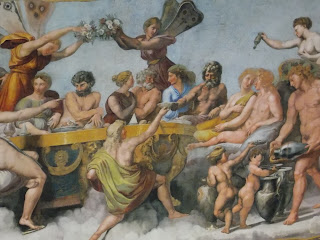Friday July 6.
Due to a transit strike today our
schedule has changed. Rather that go to the Villa Borhgese as
planned, we will go to St Maria Minerva, and then the Villa
Farnesina. Up until this point, we have focused primarily on the
monuments and churches and the role that the artwork and architecture
had in Roman life. The imagery and iconography found in the Empirical
monuments was designed to reinforce the strength of a particular
leader, to gain favor of the people, or to boast of victory's on the
battlefields. The artwork of the churches, throughout the centuries
that we have studied, is produced to help the citizens of Rome to
understand the political or religious climate in that time.
Throughout each of the classical textbook art history stages, these
themes remain true. Today we will have a chance to look at the art of
Rome from a different perspective, art in a secular setting.
But first, we will stop at Santa Maria
Minerva. Minerva is a 13th century Dominican church built
on the ruins of the Temple of Minerva. The early Renaissance church
has elements of Gothic design, such as vaults. However it was
restored in the 19th century so there have been many
changes. The church is dedicated to the patron saint Catherine of
Sienna, known as the saint to give dowries to young women.
This church is home to one of
Michelangelo's early commissions, Risen Christ. The sculpture stands
at the base of the alter. It was created between the years of 1514-21
in Florence and transported to the church. The sculpture originally
was created to be nude, but the Dominican church covered the genitals
with a bronze leaf. Although art critics of today consider this to be
one of Michelangelo's lesser works, it was highly praised in its
time. Sebastiano Del Piombo said at the time, “the knees of that
figure are worth all of Rome.” The sculpture has elements that all
Michelangelo figures have, an idealized muscular male body,
proportions skewed for dramatic emphasis, a classical contrapasto
pose. All of these can be found in many of Michelangelo's works. The
King of France ordered a bronze copy of this sculpture, however, it
is often left out of catalog listings of Michelangelo's works. As a
side personal note, I GOT TO TOUCH IT!!!!!!
Our next stop is the Villa Farnesina.
Located in the Trasevere side of the Tiber, the Villa was the country
home of the Roman banker Agostino Cigi. Cigi was a patron to Raphael
and hired him to decorate the villa. Cardinal Farnese took over the
villa in 1580, thus it's current name. The Villa gives us a chance to
see Roman life at a more personal level. These rooms were not
decorated to inform the public, they were designed for the enjoyment
of the owner and his guests. Many pagan scenes can be found here.
Painting designed to initiate conversations, to provoke emotions, and
for pure whimsy. The most notable of the frescoes here are Raphael's
“Galatea” from 1512, and the Loggia of “Cupid and Psyche,”
done by Raphael and his assistants in 1518-19. When Raphael painted
Galatea, the nymph goddess, she was purely from his imagined ideal of
beauty. His color palette is inspired by ancient Roman art.
The garden entrance is home to the
ceiling frescoes depicting mythical scenes from Cupid and Psyche.
Included in these provocative scenes is the Nuptial Banquet, Kiss
Between Cupid and Jupiter, and Mercury accompanying Psyche to
Olympus. The story, originally written in Apuleius' The Golden Ass,
is quite a departure from the works that we have seen so far. We are
moving into Renaissance art... my favorite art period!






No comments:
Post a Comment